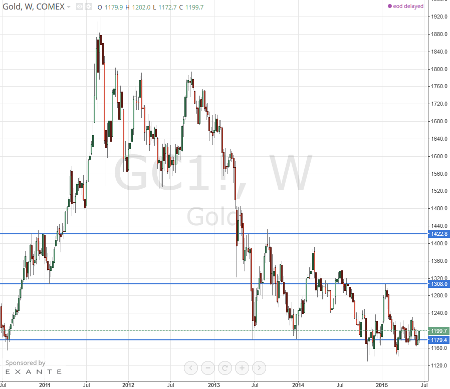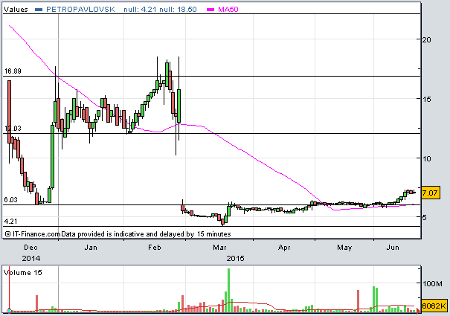Petropavlovsk: A phoenix from the ashes?
19th June 2015 12:26
by Lee Wild from interactive investor
Share on
A major charm offensive is underway at . It's three months since a bitter battle with dissident shareholders ended with a rescue rights issue and new $100 million convertible bond. The experience has clearly shaken founder and chairman Peter Hambro, and repairing damaged market credibility will take time. But Hambro and his team have sunk their personal fortunes into the business and will not have done so without good reason.
"It was off the scale about how awful it was," Hambro told Interactive Investor of his dust up with investment group Sapinda. "People behaved so badly it was hard to believe." Sapinda, which had taken a 10% stake in Petropavlovsk - named Peter Hambro Mining until 2009 - wanted to vote down the $235 million rights issue and see the company into receivership.
Of course, they failed, and Hambro finally got the 157-for-10 cash call away at 5p a share. Hambro set up the company in 1994 with Pavel Maslovskiy - Petropavlovsk combines the Russian spellings of Peter and Paul - who is now chief executive again. Both spent millions of dollars on rights shares and now own 4.6% and 6.6% of the company respectively.
That reduced the company's substantial debt burden to about $707 million compared with a peak of $1.2 billion in March 2013. Analysts at house broker Bank of America Merrill Lynch think Petropavlovsk can reduce borrowings by $100-$200 million a year for the next two years. Even the company thinks it will drop below $600 million within six months if gold sticks around $1,200/ounce (oz).
Where did it all go wrong?
A lot of debt was racked up developing the Malomir deposit. Refractory ore there is easy to mine, but expensive to process - it requires pressure oxidation (POX) facilities and flotation plants. That's okay when gold prices are high, but not so good when they've crashed. Prices plunged from over $1,900/oz in 2011 and almost $1,800 a year later, to below $1,200 currently.

Source: TradingView
As a result the share price plunged, too, down from over 450p in 2010. And Hambro is clearly upset at the plunge in the company's valuation. "I feel ashamed at what happened to the share price, but the only defence was to give shareholders a chance via the rights issue," he told us over a coffee recently.
It's not the first time Hambro has moaned about the share price. In the 2011 annual report, he said: "It both saddens and perplexes me that the price at which the company's shares change hands on the Stock Exchange reflects neither the achievements set out above nor the great potential that the group has to continue to develop and grow its business."
He blames "misinformation and short positions" for the current lack of institutional support. Getting at least one of them interested would be a big catalyst for the share price. If the AGM on Thursday 18 June doesn't generate interest, maybe a recent analysts visit to each of Petropavlovsk's four operating assets - Pokrovsky, Malomir, Pioneer, and Albyn - in the Amur region of eastern Russia.
And there's Petro's 45% stake in IRC. Chaired by Hambro's son Jay, the Hong Kong-listed Russian iron ore miner has struggled in the past few years, plunging in line with a slump in iron ore prices. A planned investment by China's General Nice to get Petro's stake below 41% is taking time to complete, too. It's currently classified as "held for sale", but if the final part of the Chinese investment does not happen within the next year, IRC could be reconsolidated on the group's balance sheet, significantly increasing net-debt. IRC shares, down over 80% since 2011, have at least risen more than 50% over the past three months.
Site visit generates interest
Fresh off the plane, Bank of America analyst Ed Faritov is certainly impressed with the business and thinks the shares are worth 10p rather than 7p at present. Canaccord Genuity, which also flew out to Russia, now believes they could be worth 12p.
Faritov points out that the rights issue fixes the balance sheet, the weak rouble helps costs - 85% of Petro's costs are now exposed to the rouble - and he sees $100-200 million in cash flow to equity for three to four years on a market cap of $300 million.

"Time spent with management on the site visit confirmed our thesis: POG should deliver stable (potentially growing) production from easy-to-treat oxidized ore, lower costs / capex will drive FCF [free cash flow] growth, leading to EV [enterprise value] transfer from debt to equity holders," he writes. Faritov now estimates net debt/cash profit [EBITDA] of just 1.5 times by the end of 2015, with share of equity in enterprise value jumping from 30% to 50%.
And Canaccord argues that while Petro's debt problems have left it with "a credibility issue to overcome in the market," the shares are a 'speculative buy'. "We note the risks, but also note that if the company can hit its anticipated production and cost targets, aided by further non-refractory exploration success and further progress on the potential underground mining project at Pioneer, then we believe that a positive re-rating of the shares is possible."
What now?
With the rights issue over, Petro is getting its finances in shape. But there's much to do. Hambro wants total average cash cost of production below $700/ounce this year from $865 in 2014. To do that costs will be cut by 10-15%, although Canaccord thinks that's conservative and 20-25% could be possible. A weak Russian rouble should also help, as will processing higher grade ore. The broker believes that costs could be nearer $600/oz in 2015.
Capital expenditure is down, too, from $644 million in 2011 and $97 million in 2014 to just $35 million this year - $24 million on exploration programme and $11 million development and maintenance. Expect about $45 million a year after that.
Production, too, is tipped to pick up again. After more than a decade of annual production increases, output fell last year from 741,000oz to 625,000oz, partly due to the sale of Petro's Berelekh alluvial operation in 2013. Look for 680-700,000/oz in 2015, according to the company, then over 617,000oz the year after. "We've never missed an annual target," Hambro told us. "That's taken a lot of skill, but we've also been lucky."
Watch out for a revised ore reserve and resource in August, too, according to Canaccord. "From what we have seen we anticipate a further increase in nonrefractory ore volumes (with the likelihood of more to come with additional exploration) that should prolong production from existing RIP [resin-in-pulp] processing facilities and delay the need to complete the POX [Pressure Oxidation] facilities in the near-term."
Currently, Petro has proven and probable reserves of 9.2 million ounces (Moz) and 23.3Moz of measured, indicated and inferred resources. In 1999, it was 1.7Moz and 1.3Moz respectively, since when the company has produced 5.4Moz, implying significant exploration success. Further discoveries are possible around existing plants.
Gold must shine
There may even be a fillip from gold prices. Bank of America metals analyst Michael Widmer argues in a recent note that we're "on the cusp of a gold bull market". Fear of US rate hikes has held back gold prices, he says, but believes aggressive tightening is unlikely - the latest Federal Reserve rate meeting certainly suggests that will be the case. "Hence, we believe once muted rate increases get priced in, gold should push higher, reflected in our base case for the metal to average $1,500/oz by 4Q17."
And Bank of America's valuation does very much depend on a bullish view of gold, with a material deleveraging needing an average gold price of around $1,300/oz over the next several years.
Of course, this means nothing if Russian politicians interfere. Political risk is "impossible to quantify", admits Hambro. However, he's spent over 30 years in the country, and knows his way around. Non-executive director Sir Roderic Lyne - British Ambassador to Russia from January 2000 until August 2004 - sits on the board, too. Remember also that Russia gets a 6% royalty on Petro's production. It's also a big employer and pays local taxes.
Petropavlovsk is unloved, and overcoming credibility issues will be neither quick nor straightforward. It's essentially a high risk play on the gold price. But if actions being taken by the company - lower costs, capex cuts, stable production and driving free cash flow growth - are successful, it could force a change in perceptions among City sceptics.
This article is for information and discussion purposes only and does not form a recommendation to invest or otherwise. The value of an investment may fall. The investments referred to in this article may not be suitable for all investors, and if in doubt, an investor should seek advice from a qualified investment adviser.